
Headings immediately provide structure and help the reader to find their way around your academic writing. They start a paragraph, chapter, or page and tell you what the following content is about. Learn how to write them, how long they should be, the difference between them and titles, and much more. With this article, you will learn how to write an effective heading that will get the reader’s attention and encourage them to continue reading.
Definition: Headings
When writing academic essays or research papers, you should maintain a logical flow of ideas throughout the work. This is when headings as textual markers come into play. They can be found in documents, web pages, and other written materials that indicate the hierarchy, structure, and organisation of content. They organise text into sections and subsections, making it easier for readers to navigate information. Furthermore, they demonstrate the relative importance of different sections through varying levels, such as “Heading 1” for main titles, followed by smaller subtitles for detailed breakdowns. They enhance accessibility, allowing users, especially those with disabilities, to understand the structure of the content more easily. In web content, they also play a crucial role in search engine optimization (SEO) by helping search engines understand and rank the page content, making it more discoverable to users. Essentially, they are about structuring content to improve readability, navigability, and comprehension.
Special headings
Special headings are specific types that serve unique purposes within a document or publication. These are typically used in academic papers, research articles, reports, or other formal documents to organise and present information in a structured manner. Here are some of the common ones:
- Abstract
- Paper title
- References
- Footnotes
- Appendix
Headings vs. titles
Section titles and titles play a crucial role in the writing process of academic works in university, school, and even work. However, these two terms serve different purposes. Read on to find out what sets them apart.
| Headings | Titles | |
| Definition | Represent certain sections | Represents the entire work |
| Function | Shows where to find what information | Grab attention and convey the main theme |
| Levels | Can vary in level | No different levels |
| Content | Text based on the following section | Text based on the whole document |
| Length | Not strictly short | Preferably short and precise |
| Number | Several | Only one |
Subheadings
Subheadings, or subtitles, are titles used within a document to organise content into sections, making it easier for readers to navigate and understand the material. In an academic context, subheadings are crucial for structuring papers, reports, and articles. They help break down complex information into manageable parts, highlight key topics, and provide a clear content roadmap.
Different style guides
There are various style guides used by universities worldwide. However, each of them has its guidelines on formatting, etc. Below, we provide a brief overview of the three most important style guides and their specifications for formatting headlines.
Note: It is important to know in advance that headline-style capitalization refers to a formatting style in which the first and last words are capitalized.
For the APA style heading format, the following rules apply:
- Level 1: Centered, boldface, title case
- Level 2: Flush left, boldface, title case
- Level 3: Flush left, boldface, italicized, title case
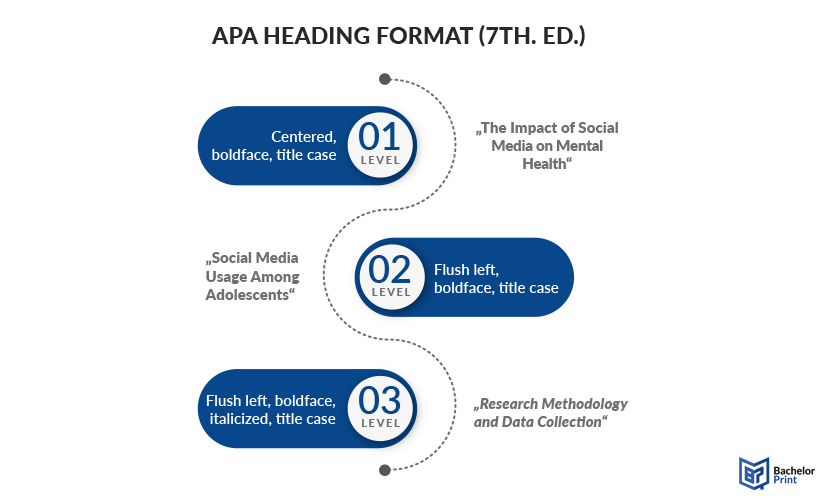
For the MLA style heading format, the following rules apply:
- Level 1: Flush left, boldface, title case
- Level 2: Flush left, title case
- Level 3: Flush left, italicized, title case
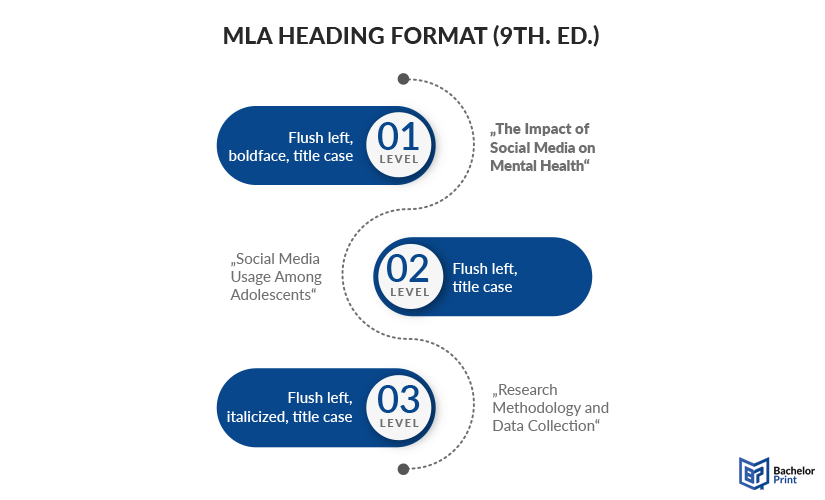
For the Chicago Style heading format, the following rules apply:
- Level 1: Centered, boldface or italicized, headline-style capitalization
- Level 2: Centered, regular type, headline-style capitalization
- Level 3: Flush left, boldface or italicized, headline-style capitalization
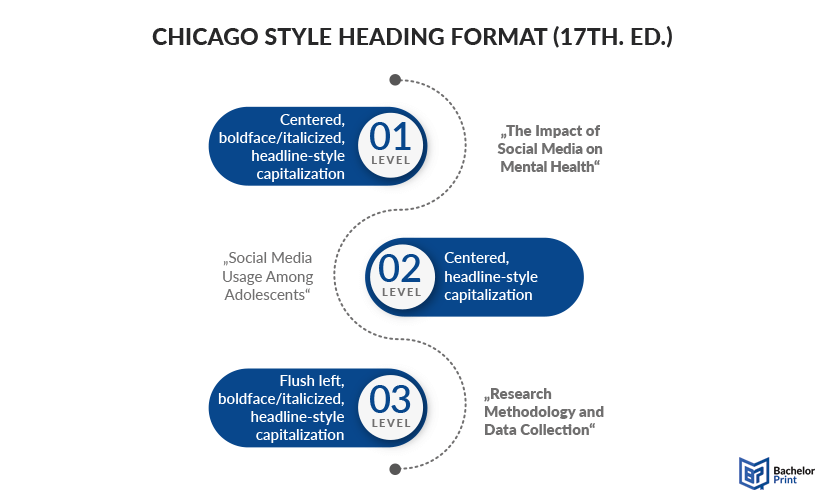
What to pay attention to
There are certain aspects, when creating a proper section title, you should pay attention to. Below, we’ll explain this and afterward you’re a pro when crafting your paper.
For your academic essays, you should incorporate some descriptive headings to provide the reader with clear information for easy understanding. When used effectively, the lecturer, or reader will peruse your document and know what it’s about simply by reading the headlines.
Some tips on how to be as descriptive as possible are:
- Be specific by focusing on the section
- Use key terms for more searchability and comprehension
- Avoid ambiguity to prevent confusion
The first one is too vague and does not provide specific information about the section’s content. In contrast, the second one clearly describes the information and sets appropriate expectations for the reader.
Chapters cannot have the same content; therefore, the section titles can’t be the same, too. Knowing how to write a headline that is as descriptive as possible will help arrange your ideas and give the reader an easy time. Having the same title twice can dilute your work and immensely affect your grading.
Essential tips on how to write a headline without repetition are:
- Varying the lengths
- Using transition words
- Using the thesaurus to get synonyms
In the first example, it is unclear which features are being discussed in each section. The second examples are unique and refer to different paper sections, which helps in differentiating the content and improves the overall clarity.
Add a heading in Word
Firstly, you open up the document in Microsoft Word you’d like to create headlines for. Right at the beginning, you will see the Home tab, where you can also set the font and size. Right in the middle, you will find a fold-out column titles Styles that allows you to format your text into any headline you like (refer to the picture below). If you click on the arrow, you’ll see there are more types of section titles, if there isn’t one you like.

That’s how easily you format a headline in a Word document.
Note: You can change the format by simply hovering over the style while marking the text. You do not have to click on the heading style to find out how it’ll look.
If you want to take it one step further, you can even create your own style when folding out the Styles tab. You have two choices here. One involves changing an existing headline, whereas the other option involves creating an entirely new one.
- Click on “Create a Style” and then “Modify” to create a new style
- Right-click on an already existing style and customize it by selecting “Modify”
See the images below for a visual representation.
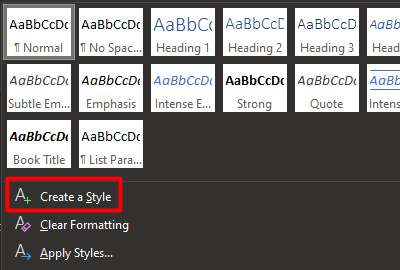
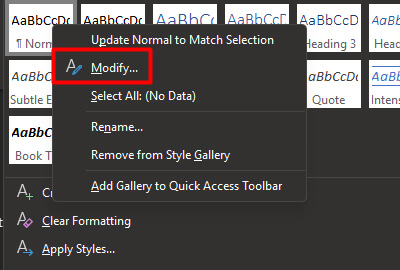
- ✓ 3D live preview of your individual configuration
- ✓ Free express delivery for every single purchase
- ✓ Top-notch bindings with customised embossing

Technical terms in headings
Technical and jargon terms used in headlines of documents may not be understandable to every reader except those familiar with the languages. An example is site language, most commonly found in search engine optimization (SEO).
Different heading levels are used to communicate the site structure to Google. There are different heading ranks and they are referred to as follows:
- H1 = Most important; typically used for the main title of a page/article
- H2 = Section titles; used as content headings
- H3 = Subsection titles; divides the content within a paragraph
- H4 to H6 = Least important; additional, optional levels for structuring
FAQs
A heading is a title or label used in written content to organise and indicate the structure of the information. It helps readers navigate through the text and understand its main topics and subtopics.
Here’s an example when writing about time management techniques and strategies aimed at enhancing productivity and efficiency in various aspects of life, such as work, school, or personal activities.
- “Effective Strategies for Improving Time Management Skills”
- A title stands for the whole reading and incorporates its content in a phrase or two.
- A heading only crowns and captures the content of a section or chapter.
They convey an overview of what the entire paper is about. The reader is supposed to find out what the entire document is about by going through the sections assigned.
A rule of thumb is to never go past one line because it’ll be too long. A good, understandable headline for your sections or paragraphs should intrigue the reader to read more and not be too long to bore them.
